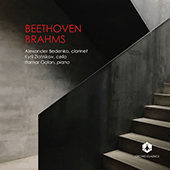During one of the idyllically discussed Philadelphia Orchestra golden ages, music director Eugene Ormandy (ca. 1960) was sometimes compelled to change programs if key principal players were not able to perform. That past is a foreign country: we’re now in an age when the proficiency and artistry among classical musicians is at a level where the second- and maybe third-in-command can capably step in to cover most any situation, barely batting an eye.
That’s why, when working as a music critic in Philadelphia, I’m almost used to hearing from and about musicians that are among the best out there, though I’ve barely heard of them. So it was when I was approached via email by clarinetist Alexander Bedenko, a Curtis Institute graduate, who had just come out with a disc of Beethoven’s Clarinet Trio Op. 38 and Brahms’s Clarinet Trio Op. 114 on the reputable boutique label Orchid. I didn’t even have to wait for sound files; the music was already available for streaming on Naxos Music Library. And I’d recommend it to anybody.

All three musicians are in early middle age and have thick, impressive resumes. The Ukraine-born, Philadelphia-based Bedenko seems to be the substitute clarinetist of choice for any number of Big Five American orchestras. Belarusian cellist Kyril Zlotnikov has recorded the Mozart piano trios with Daniel Barenboim and Nikolaj Znaider. Lithuanian pianist Itamar Golan, who teaches in Paris, has played chamber music everywhere and with everybody. As with all great chamber music groups, you’d be happy to hear any of them individually, but together, there’s genuine synergy. And that’s exactly what Beethoven’s Op. 38 needs.
Even with so many Beethoven 250th birthday concerts being cancelled, the world needs to hear pieces from this composer that haven’t already been played a zillion times. The Op. 38 is easy to pass off as a second-hand piece, since it’s drawn from his once-popular Septet Op. 20. In fact, Op. 38 is solid, middling, perfectly engaging Beethoven: Though its melodies aren’t memorable, they feel quite attractive in a performance such as this.
Incidental solos need to sparkle from a technical standpoint and be thoughtfully phrased for maximum expressive impact — though within the bounds of Viennese classicism, the Haydn/Mozart world that Beethoven later outgrew. One has a sense that Beethoven didn’t always know what to do with the clarinet: it often seems along for the ride, doubling some melodies and echoing others, usually with the piano taking the lead. Since he was a virtuoso pianist, Beethoven’s earlier chamber works often seem like piano sonatas with passengers, partly to make them more viable for home-concert use. No question that pianist Golan is in total sympathy with the piece, though the soul of any Beethoven score is the thematic development. Thanks to the elastic interplay among the players, that quality is ever present, especially in the fourth-movement variations.
The Brahms is a different story, a work written partly out of an admiration for clarinet virtuoso Richard Mühlfeld that prompted the composer to rethink his retirement. Oddly, Brahms doesn’t necessarily spotlight the clarinet: as in the Beethoven, the instrument still spends a certain amount of time doubling the cellist. Brahms’s pieces are so integrated that even when quoting Wagner they still sound like Brahms; you feel that particularly strongly in late works such as this.
Again, Golan’s treatment of the piano writing is the piece’s angst-ridden but solid foundation. But with the long-reaching, lyrical lines given to the clarinet, Bedenko is like a gentle, quietly radiant beacon guiding one’s ear effortlessly into the emotional center of whatever is happening in the music at any given time.
Philadelphia Orchestra principal clarinetist Ricardo Morales has opened up lyrical possibilities with the instrument that I hadn’t previously realized were possible. But the presence of players such as Bedenko shows that Morales is not the only revelation out there. I’ve read reviews that complain about boutique labels such as Orchid issuing the same repertoire time and again. But such outfits don’t function to build up a catalog. They’re there to allow musicians to be heard.

